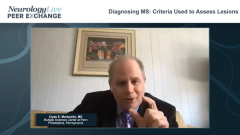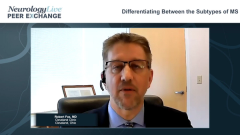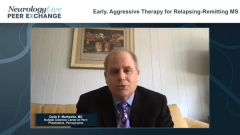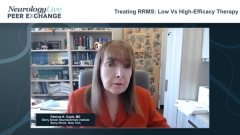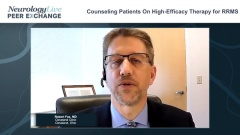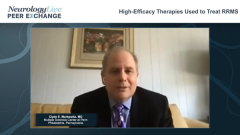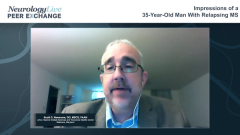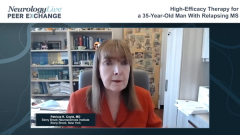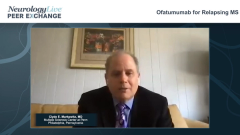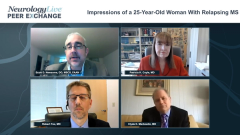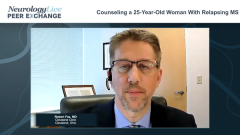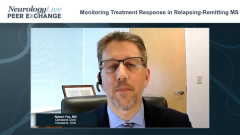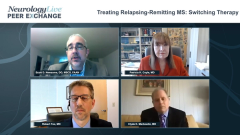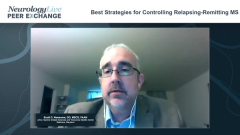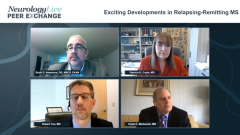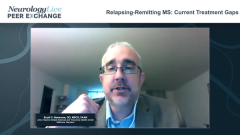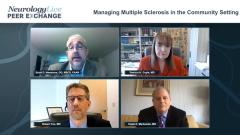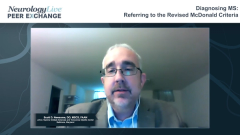
Counseling Patients On High-Efficacy Therapy for RRMS
Robert Fox, MD, of the Cleveland Clinic, comments on the advantage of starting treatment with a high-efficacy therapy for relapsing-remitting multiple sclerosis and explains his approach to counseling patients when selecting treatment.
Episodes in this series

Scott D. Newsome, DO, MSCS, FAAN: Bob, tell us a bit about your practice, when you’re discussing with what the options are the patient sitting in front of you. Are there specific criteria that sway you to think you need to go down the high-efficacy path and what that discussion involves? Are there advantages? How do you relay that information to the patient?
Robert Fox, MD: First, why do we do this? What would be the advantage of the aggressive approach? As Pat Coyle was describing, we are trying to prevent injury. In fact, that is the name of the game, in not just MS [multiple sclerosis] but all medicine. As health care providers, we are much better at preventing the disease injury to a patient’s God-given organs than we are at fixing the organ once it is injured. That is true whether we are talking about stroke, heart attack, kidney failure, metastatic cancer, or whatever else. We are much better at preventing it or nipping it in the bud when it develops than we are at trying to fix a broken organ. MS is no different. What we are trying to do is prevent the injury to the brain, the optic nerve, and the spinal cord from the MS and balancing that out with the risk. That is the rub.
As we were just mentioning, not all patients need an aggressive therapy. Right now, we do not know how to identify which patients need the aggressive therapy up front and which patients we can gradually escalate very well. The TREAT-MS and DELIVER-MS trials are ongoing; Scott, you are leading 1 of them. Another is being led at our institution, the Cleveland Clinic. These trials will be critically important in understanding whether we start with the biggest gun right out of the gate or gradually work our way up over time. Over the next couple of years, we should be getting answers to that. Until we do, we are faced with that situation.
Scott, describe what we do when we have a patient sitting in front of us: How do we decide whom we are going to recommend the aggressive therapy to and whom we are not? A couple of things I look at are how much injury they already have, what their lesion load is based on the brain MRI and the spinal cord MRI, and how much incomplete recovery have they had from their relapses—meaning if they can afford to have more relapses. If they are not recovering from their previous relapses, then they will not recover as well from subsequent relapses. Can they afford more injury? For spinal cord involvement, we know that if the MS has a predilection for the spinal cord, that is going to cause more injury over the longer term, and it predisposes patients to then develop secondary progressive MS with many large enhancing lesions. Those are the things that would sway me toward an aggressive therapy.
The other aspect that we have not talked about— I know this is a passion of Pat’s—is the shared decision-making of bringing the patient into this. Some patients say, “I want to do absolutely everything I can do. I will take whatever risk necessary.” Other patients say, “Drugs are toxic. I do not like drugs. I want to minimize and avoid drugs as much as I can.” That is the patient preference on those 2 ends, and then patients fill in between as well. What is the patient’s tolerance for the risk we have for therapies? What is the patient’s tolerance for doing things that might not be necessary but we do not really know about? We could recommend it, or we could say they can go slow. A patient’s comfort level with the risks of our therapy is also an important aspect when talking about the intensity of the initial therapy.
Scott D. Newsome, DO, MSCS, FAAN: Absolutely. I always teach our fellows and residents that the best medication for the patient is the medicine they will take.
Robert Fox, MD: Right.
Scott D. Newsome, DO, MSCS, FAAN: We know what untreated MS can get the person into, so it is important to have that shared decision-making.
Thank you for watching this Neurology Live® Peer Exchange. If you enjoyed the content, and I hope you did, please subscribe to our e-newsletters to receive upcoming Peer Exchanges and other great content right in your in-box.
Transcript Edited for Clarity
Newsletter
Keep your finger on the pulse of neurology—subscribe to NeurologyLive for expert interviews, new data, and breakthrough treatment updates.

